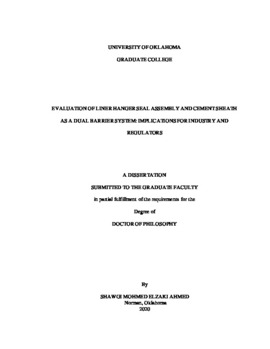| dc.contributor.advisor | Salehi, Saeed | |
| dc.contributor.author | Ahmed, Shawgi | |
| dc.date.accessioned | 2020-05-07T19:52:31Z | |
| dc.date.available | 2020-05-07T19:52:31Z | |
| dc.date.issued | 2020-05-08 | |
| dc.identifier.uri | https://hdl.handle.net/11244/324317 | |
| dc.description.abstract | Robust dual barrier systems are crucial for well integrity. Regulators and industry have consistently raised the concerns in such systems regarding the testing, qualification, and prediction of leakage pathways and failure modes. Liner hanger is an example of dual barrier system in which seal assembly and cement sheath act as two barrier elements.
The objective of this study is to evaluate the performance characteristics of the liner hanger dual barrier system and to identify the risks of failures that could compromise the wellbore integrity. In this study, the performance of the liner hanger dual barrier system was evaluated using experimental and numerical approaches. Results of experiments revealed that elastomers’ sealability was not affected after they were exposed to a surfactant degradation. However, the seals failed the pressure tests when they had mechanical defects present and also after exposure to carbon dioxide. The results also revealed that neat Class H cement requires gas migration control additive to act as a primary barrier. In addition, wait-on-cement (WOC), pipe material and surface roughness play key roles in the strength of cement bonding.
Finite element analysis (FEA) models were developed to evaluate the performance of the liner hanger dual barrier system. The results disclosed that elastomer contact pressure (sealability) mainly depends on the compression ratio, seal materials, pipe materials, and volumetric swelling. The friction coefficient at the seal-casing interference has a minor effect on the contact pressure. Results also showed that tensile hoop stress is the most dominant factor which compromises the cement hydraulic and mechanical integrity.
The contribution of this research can advance performance evaluation guidelines of the liner hanger dual barrier system in terms of failure modes prediction and operational limits identification. In addition, the research highlighted some of the gaps in current industry standards and regulatory guidelines that need further considerations. | en_US |
| dc.language | en_US | en_US |
| dc.subject | Well integrity | en_US |
| dc.subject | Elastomers | en_US |
| dc.subject | Dual barrier | en_US |
| dc.subject | Liner hanger | en_US |
| dc.title | EVALUATION OF LINER HANGER SEAL ASSEMBLY AND CEMENT SHEATH AS A DUAL BARRIER SYSTEM: IMPLICATIONS FOR INDUSTRY AND REGULATORS | en_US |
| dc.contributor.committeeMember | Teodoriu, Catalin | |
| dc.contributor.committeeMember | Ahmed, Ramadan | |
| dc.contributor.committeeMember | Karami, Hamidreza | |
| dc.contributor.committeeMember | Stalford, Harold | |
| dc.date.manuscript | 2020 | |
| dc.thesis.degree | Ph.D. | en_US |
| ou.group | Mewbourne College of Earth and Energy::Mewbourne School of Petroleum and Geological Engineering | en_US |
